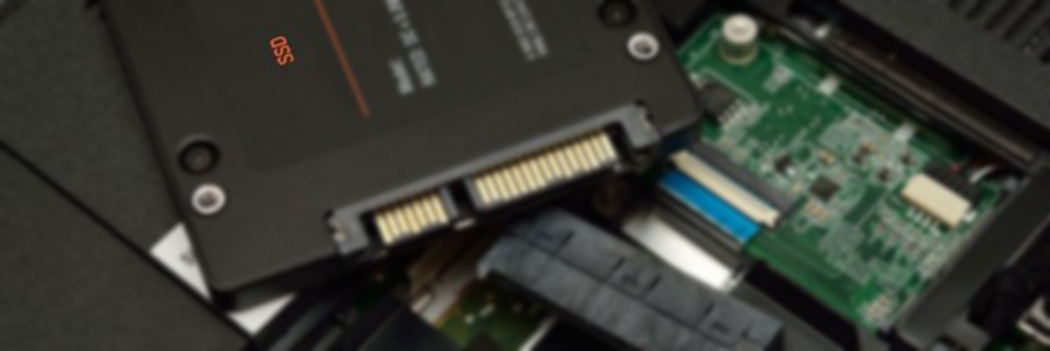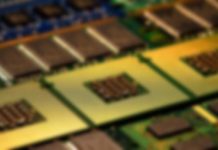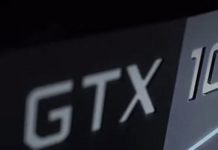This article has been just updated: January 16, 2024
The importance of storage devices is often greatly underestimated by gamers and computer users in general. In fact, the reason why computers today feel much faster and more responsive than they did 10 years ago has much more to do with Solid State Drives (SSDs) than with CPUs and GPUs.
Instead of physical disks, an SSD uses integrated circuit assemblies as memory to store data persistently. First generations of SSDs used traditional hard disk drive (HDD) form-factors and protocols such as SATA and SAS, but SSD manufacturers have since then embraced the NVM Express protocol, which has been designed to capitalize on the low latency and internal parallelism of SSDs.
If you’re ready to say goodbye to excruciatingly long loading times, we know which SSDs in 2024 are worth buying. As with all other storage devices, you pay not only for storage space but also read/write speeds and extra features.
These days, you can buy enterprise-grade SSDs with certified reliability, but those are overkill for the average computer user. Instead, we recommend you stick to our selection of the top 7 best SSDs to get the best value for your money.
| SSD | Speeds | Price(according to Amazon) |
|---|---|---|
| 1. Samsung 860 Evo | 550 MB/s read and 520 MB/s write | $169 for 500 GB |
| 2. Corsair Force Series MP510 | 3,480 MB/s read and 3,000 MB/ write | $129 for a 480 GB |
| 3. Samsung 970 Evo | 3,400 MB/s read and 2,300 MB/s write for the 500 GB version | $230 for 500 GB |
| 4. WD Blue 3D M.2 | 545 MB/s read and 525 MB/s write | $105 for 500 GB |
| 5. Crucial MX500 | 444.41 MB/s read and 451.06 MB/s write | $74.99 for 500 GB |
| 6. Intel 750 Series | 2,200 MB/s read and 900 MB/s write | $389 for 400 GB |
| 7. Adata XPG SX8200 SSD | 3,200 MB/s read and 1,700 MB/s write | $115 for 480 GB |
1. Samsung 860 Evo
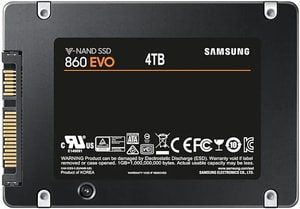
The Samsung 850 Evo will forever be remembered as one of the most successful—if not the most successful SSD—ever created. The Samsung 860 Evo has managed to successfully follow in its footsteps, offering improved read and write speeds, significantly better endurance, and attractive price. The smallest version of the Samsung 860 Evo has 250 GB, while the largest version has whopping 4 TB of storage space. The SSD is limited by the SATA 3 protocol, but that’s true for all non-NVM Express SSDs.
Speeds: 550 MB/s read and 520 MB/s write
Pros: Noticeably faster than the Samsung 850 Evo. Reliable and affordable. Unassuming design that should please most PC enthusiasts.
Cons: Limited by the SATA 3 protocol.
2. Corsair Force Series MP510

The Corsair Force Series MP510 is a popular NVM Express SSD that doesn’t fail to surprise with its incredible sequential performance and good power efficiency. Best of all, the 480 GB version of the Corsair Force Series MP510 costs just $129.99, making it a true bargain for anyone who wants extreme storage performance without paying an extreme price for it. Another thing we like about this SSD is its black PCB, which makes it stand out in just the right way.
Speeds: 3,480 MB/s read and 3,000 MB/s write.
Pros: Extreme performance without an extreme price. Black PCB. Power efficient design.
Cons: Slightly slower compared with other NVM Express SSDs.
3. Samsung 970 Evo

Samsung has made a name for itself with the beloved Samsung 850 Evo, and the Samsung 970 Evo has similarly lofty aspirations: it wants to deliver breakthrough speeds thanks to NVM Express technology to enhance high-end gaming and 4K & 3D graphics editing. The SSD is very similar to the prosumer-grade Samsung 970 Pro, but much more affordable. You can get it with up to 2 TB of storage capacity, so there’s no reason to use a slow external hard drive for large files.
Speeds: 3,400 MB/s read and 2,300 MB/s write
Pros: Similar architecture to the more expensive Samsung 970 Pro. Incredible performance. Available in many different sizes.
Cons: Larger models offer better value than smaller models.
4. WD Blue 3D M.2

The WD Blue 3D M.2 uses 3D NAND technology to offer higher storage capacities and reduced cell-to-cell interference for enhanced reliability. As far as SATA SSDs go, the WD Blue 3D M.2 is very power efficient and capable of rapid transfer speeds. We wouldn’t recommend it for a high-end gaming PC because there are several NVM Express SSDs that don’t cost much more, but if you want a reliable storage device with an aggressive cost per gigabyte and admirable performance, the WD Blue 3D M.2 is a great choice.
Speeds: 545 MB/s read and 525 MB/s write
Pros: Excellent for multimedia computers. Capacities up to 2 TB. Decent read and write speeds. Available in two form-factors.
Cons: Slower than the incredibly popular Samsung 850 Evo.
5. Crucial MX500
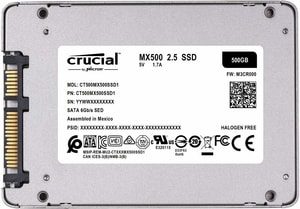
Crucial knows that the MX500 SATA SSD won’t break any speed records. That’s why it advertises its value, which is truly incredible. If you have a computer that still has a traditional hard drive, the Crucial MX500 is everything you need to reduce your boot time to just a few seconds and enjoy solid all-around performance. What’s more, Crucial includes a 5-year limited warranty on the SSD and backs it with its helpful service and support.
Speeds: 444.41 MB/s read and 451.06 MB/s write.
Pros: Great value. 5-year limited warranty. Helpful customer service and support.
Cons: Below-average speeds. Uninspired design.
6. Intel 750 Series
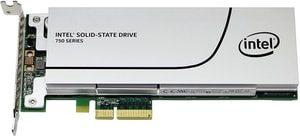
The Intel 750 is the first consumer SSD that has used the NVM Express standard to deliver ultra-fast read and write speeds. When it was first released, it was prohibitively expensive, but that didn’t stop many people from buying it. Today, you can often find it on eBay for a great price, and you shouldn’t be afraid to buy it used because reliability is one of its strong suits.
Speeds: 2,200 MB/s read and 900 MB/s write
Pros: Reliable. Readily available on eBay. Fast compared with SATA SSDs.
Cons: Limited availability. First-generation performance.
7. Adata XPG SX8200 SSD
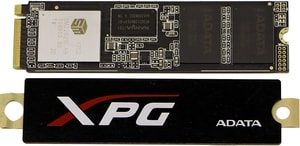
The XPG SX8200 is the fastest SSD Adata has ever created. It’s designed for PC enthusiasts who want maximum performance, which it delivers thanks to NVM Express 1.3. Because the Adata XPG SX8200 SSD supports LDPC (low-density parity check) error correcting code technology, you can trust it even with your most sensitive data and know that it will serve you well for many years to come.
Speeds: 3,200 MB/s read and 1,700 MB/s write.
Pros: Great everyday performance at an affordable price. Likable design.
Cons: Slower write speeds.
Conclusion
Traditional hard drives won’t disappear anytime soon, but unless you need heaps of storage space for as little money as possible, you should buy an SSD instead. If you’re a regular computer user, an affordable SATA SSD such as the Samsung 860 Evo is a sensible choice. But if you enjoy playing games or use demanding software applications on a regular basis, you should pay extra for an NVM Express SSD such as the Samsung 970 Evo to fully capitalize on the low latency and internal parallelism of SSDs.
FAQ
What were some of the top performers in the SSD market in 2024?
The SSD market in 2024 saw several high performers such as the Samsung 970 Pro, Western Digital WD Black SN750, Crucial MX500, ADATA XPG SX8200, HP EX920, Intel Optane 905P, and Samsung 860 Evo. These drives offered a combination of speed, reliability, and value for various consumer needs.
Which SSD had the best read/write speeds according to benchmarks in 2024?
The Samsung 970 Pro often topped the charts with outstanding read/write speeds, reaching sequential read speeds up to 3,500 MB/s and write speeds up to 2,700 MB/s, setting a high bar for performance.
How did the Western Digital WD Black SN750 stand out among 2024 SSDs?
The Western Digital WD Black SN750 was praised for its excellent gaming performance and the inclusion of a heatsink for better thermal management, which was particularly beneficial for users with high-intensity workloads.
What made the Crucial MX500 a noteworthy SSD in 2024?
Known for its impressive cost-to-performance ratio, the Crucial MX500 became a popular choice due to its consistent speeds and built-in data protection features, making it a solid option for budget-conscious buyers.
Was the ADATA XPG SX8200 considered a good SSD for gaming?
Yes, the ADATA XPG SX8200 was noted for its high speeds and durability, making it a suitable option for gamers seeking faster game load times and robust performance.
What were the standout features of the HP EX920 SSD?
The HP EX920 SSD was well-regarded for its balance between price and performance. With strong read/write speeds and lower cost per gigabyte, it was a versatile choice for both gaming and professional applications.
For enthusiasts and professionals, how did the Intel Optane 905P perform in benchmarks?
The Intel Optane 905P, with its 3D XPoint technology, delivered exceptional random read/write performance and endurance, aiming at workstation users and enthusiasts who required top-tier responsiveness and reliability.
What factors made the Samsung 860 Evo one of the best SSDs in 2024?
The Samsung 860 Evo combined reliable performance, strong encryption features, and a broad range of capacity options, making it a go-to SSD for a wide spectrum of users, from casual to professional.
How did benchmark results influence consumer choice in SSDs for high-intensity tasks?
Benchmark results showcasing high sequential and random read/write speeds, as well as endurance ratings, guided consumers in picking SSDs like the Samsung 970 Pro and Intel Optane 905P for high-intensity tasks that require fast data access and long-term reliability.
What aspects did gamers consider when selecting an SSD in 2024?
When gamers chose an SSD in 2024, factors such as load times, reliability, and the presence of gaming-specific features like hardware encryption and integrated heatsinks, as present in models like the Western Digital WD Black SN750, were considered.
How did the emergence of NVMe technology impact the SSD landscape in 2024?
The rise of NVMe technology brought about a significant improvement in performance over traditional SATA SSDs, with drives like the Samsung 970 Pro offering considerably faster data transfer rates that were particularly noticeable in demanding applications.
Did SSDs in 2024 offer solutions for both PCIe and SATA interfaces?
Yes, the market in 2024 catered to both interfaces, with lightning-fast NVMe PCIe SSDs like the Samsung 970 Pro and more budget-friendly SATA SSDs like the Samsung 860 Evo.
In terms of capacity, how did 2024 SSDs meet the needs of different users?
Manufacturers offered a wide range of capacities, from 250GB to 2TB or more, catering to a variety of needs, from users with modest storage requirements to power users needing extensive space for large files or data-intensive applications.
When it came to warranty and durability, which SSDs stood out in 2024?
SSDs like the Crucial MX500 and Samsung 970 Pro offered strong warranties and high TBW (terabytes written) ratings, attracting users looking for long-term reliability and peace of mind with their purchase.
Did any SSDs released in 2024 focus specifically on energy efficiency?
Energy efficiency was an important aspect for many consumers, and drives like the Crucial MX500 were highlighted for their lower power consumption, which extended battery life in laptops and reduced energy costs for desktop users.
Were there any notable budget-friendly SSDs with high performance in 2024?
Though there were several high-end options, budget-friendly SSDs such as the Crucial MX500 and ADATA XPG SX8200 provided competitive performance at a lower price point, proving to be excellent values.
What software tools were recommended for monitoring SSD health and performance in 2024?
Software like Samsung Magician for Samsung drives, and Crucial Storage Executive for Crucial drives, were popular amongst users to monitor SSD health, manage firmware updates, and optimize performance.
In 2024, were there any groundbreaking innovations in SSDs that reshaped the market?
While there were numerous incremental improvements, Intel’s Optane technology with 3D XPoint memory in the Intel Optane 905P was one of the most groundbreaking innovations, offering unmatched endurance and speed for specialized professional workloads.
Did the best SSDs of 2024 also offer robust data security features?
Many top SSDs like the Samsung 860 Evo and Crucial MX500 included robust hardware-based encryption, meeting industry standards like TCG Opal and IEEE 1667, thus ensuring user data security was a priority.
Where could consumers find in-depth reviews and benchmarks for 2024 SSDs to make well-informed purchases?
Consumers turned to reputable tech review sites such as Tom’s Hardware and AnandTech for in-depth reviews, benchmarks, and comparisons to help inform their SSD purchases.


